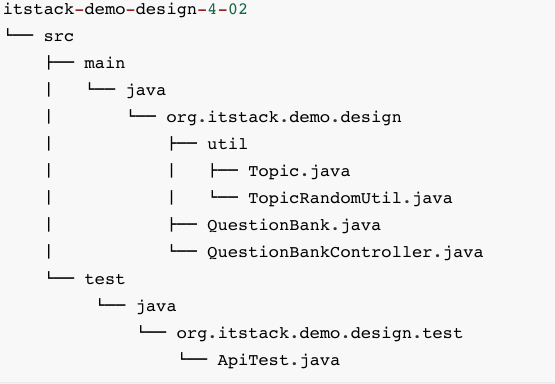适用场景:
原型模式主要解决的问题就是创建重复对象,?而这部分 对象 内容本身?比较复杂,生成过程可能从库或者
RPC接口中获取数据的耗时较长,因此采?用克隆的方式节省时间。原型模式主要解决的问题就是创建?大量量重复的类,
案例:实现一个上机考试抽题的服务,因此在这里建造一个题库题目的场景类信息,用于创建; 选择
题 、 问答题 。
选择题
/**
* 单选题
*/
public class ChoiceQuestion {
private String name; // 题目
private Map<String, String> option; // 选项;A、B、C、D
private String key; // 答案;B
public ChoiceQuestion() {
}
public ChoiceQuestion(String name, Map<String, String> option, String key) {
this.name = name;
this.option = option;
this.key = key;
}
public String getName() {
return name;
}
public void setName(String name) {
this.name = name;
}
public Map<String, String> getOption() {
return option;
}
public void setOption(Map<String, String> option) {
this.option = option;
}
public String getKey() {
return key;
}
public void setKey(String key) {
this.key = key;
}
}
问答题
/**
* 解答题
*/
public class AnswerQuestion {
private String name; // 问题
private String key; // 答案
public AnswerQuestion() {
}
public AnswerQuestion(String name, String key) {
this.name = name;
this.key = key;
}
public String getName() {
return name;
}
public void setName(String name) {
this.name = name;
}
public String getKey() {
return key;
}
public void setKey(String key) {
this.key = key;
}
}
在原型模式中所需要的非常重要的手段就是克隆,在需要用到克隆的类中都需要实现 implements
Cloneable 接口。

针对每?一个试卷都会使?用克隆的?方式进行复制,复制完成后将试卷中题目以及每个题目的答案进行
乱序处理
克隆对象处理类
public class QuestionBank implements Cloneable {
private String candidate; // 考生
private String number; // 考号
private ArrayList<ChoiceQuestion> choiceQuestionList = new ArrayList<ChoiceQuestion>();
private ArrayList<AnswerQuestion> answerQuestionList = new ArrayList<AnswerQuestion>();
public QuestionBank append(ChoiceQuestion choiceQuestion) {
choiceQuestionList.add(choiceQuestion);
return this;
}
public QuestionBank append(AnswerQuestion answerQuestion) {
answerQuestionList.add(answerQuestion);
return this;
}
@Override
public Object clone() throws CloneNotSupportedException {
QuestionBank questionBank = (QuestionBank) super.clone();
questionBank.choiceQuestionList = (ArrayList<ChoiceQuestion>) choiceQuestionList.clone();
questionBank.answerQuestionList = (ArrayList<AnswerQuestion>) answerQuestionList.clone();
// 题目乱序
Collections.shuffle(questionBank.choiceQuestionList);
Collections.shuffle(questionBank.answerQuestionList);
// 答案乱序
ArrayList<ChoiceQuestion> choiceQuestionList = questionBank.choiceQuestionList;
for (ChoiceQuestion question : choiceQuestionList) {
Topic random = TopicRandomUtil.random(question.getOption(), question.getKey());
question.setOption(random.getOption());
question.setKey(random.getKey());
}
return questionBank;
}
public void setCandidate(String candidate) {
this.candidate = candidate;
}
public void setNumber(String number) {
this.number = number;
}
@Override
public String toString() {
StringBuilder detail = new StringBuilder("考生:" + candidate + "\r\n" +
"考号:" + number + "\r\n" +
"--------------------------------------------\r\n" +
"一、选择题" + "\r\n\n");
for (int idx = 0; idx < choiceQuestionList.size(); idx++) {
detail.append("第").append(idx + 1).append("题:").append(choiceQuestionList.get(idx).getName()).append("\r\n");
Map<String, String> option = choiceQuestionList.get(idx).getOption();
for (String key : option.keySet()) {
detail.append(key).append(":").append(option.get(key)).append("\r\n");;
}
detail.append("答案:").append(choiceQuestionList.get(idx).getKey()).append("\r\n\n");
}
detail.append("二、问答题" + "\r\n\n");
for (int idx = 0; idx < answerQuestionList.size(); idx++) {
detail.append("第").append(idx + 1).append("题:").append(answerQuestionList.get(idx).getName()).append("\r\n");
detail.append("答案:").append(answerQuestionList.get(idx).getKey()).append("\r\n\n");
}
return detail.toString();
}
}
这里的主要操作内容有三个,分别是:
初始化试卷
public class QuestionBankController {
private QuestionBank questionBank = new QuestionBank();
public QuestionBankController() {
Map<String, String> map01 = new HashMap<String, String>();
map01.put("A", "JAVA2 EE");
map01.put("B", "JAVA2 Card");
map01.put("C", "JAVA2 ME");
map01.put("D", "JAVA2 HE");
map01.put("E", "JAVA2 SE");
Map<String, String> map02 = new HashMap<String, String>();
map02.put("A", "JAVA程序的main方法必须写在类里面");
map02.put("B", "JAVA程序中可以有多个main方法");
map02.put("C", "JAVA程序中类名必须与文件名一样");
map02.put("D", "JAVA程序的main方法中如果只有一条语句,可以不用{}(大括号)括起来");
Map<String, String> map03 = new HashMap<String, String>();
map03.put("A", "变量由字母、下划线、数字、$符号随意组成;");
map03.put("B", "变量不能以数字作为开头;");
map03.put("C", "A和a在java中是同一个变量;");
map03.put("D", "不同类型的变量,可以起相同的名字;");
Map<String, String> map04 = new HashMap<String, String>();
map04.put("A", "STRING");
map04.put("B", "x3x;");
map04.put("C", "void");
map04.put("D", "de$f");
Map<String, String> map05 = new HashMap<String, String>();
map05.put("A", "31");
map05.put("B", "0");
map05.put("C", "1");
map05.put("D", "2");
questionBank.append(new ChoiceQuestion("JAVA所定义的版本中不包括", map01, "D"))
.append(new ChoiceQuestion("下列说法正确的是", map02, "A"))
.append(new ChoiceQuestion("变量命名规范说法正确的是", map03, "B"))
.append(new ChoiceQuestion("以下()不是合法的标识符",map04, "C"))
.append(new ChoiceQuestion("表达式(11+3*8)/4%3的值是", map05, "D"))
.append(new AnswerQuestion("小红马和小黑马生的小马几条腿", "4条腿"))
.append(new AnswerQuestion("铁棒打头疼还是木棒打头疼", "头最疼"))
.append(new AnswerQuestion("什么床不能睡觉", "牙床"))
.append(new AnswerQuestion("为什么好马不吃回头草", "后面的草没了"));
}
public String createPaper(String candidate, String number) throws CloneNotSupportedException {
QuestionBank questionBankClone = (QuestionBank) questionBank.clone();
questionBankClone.setCandidate(candidate);
questionBankClone.setNumber(number);
return questionBankClone.toString();
}
}
原型设计模式的优点包括;便于通过克隆方式创建复杂对象、也可以避免重复做初始化操作、
不需要与类中所属的其他类耦合等。但也有一些缺点如果对象中包括了了循环引用的克隆,以及类中
深度使?用对象的克隆,都会使此模式变得异常麻烦。
原文:https://www.cnblogs.com/RealGang/p/14887614.html